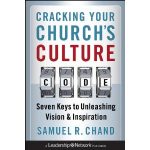Samuel R. Chand. Cracking Your Church’s Culture Code: Seven Keys to Unleashing Vision and Inspiration. Jossey-Bass: 2011. ISBN: 9780470627815.
Samuel R. Chand is an author, conference speaker, and consultant. He has written five books including Cracking Your Church’s Culture Code: Seven Keys to Unleashing Vision and Inspiration (2011), Ladder Shifts: New Realities, Rapid Change, Your Destiny (2006), What’s Shakin’ Your Ladder? 15 Challenges All Leaders Face (2005) and co-authored an additional six books. Through a business he founded, Chand has become a non-profit leadership expert who speaks at conferences and works with churches. Chand is currently President Emeritus at Beulah Heights University: an institution where he previously served as President.
Note: In Cracking Your Church’s Culture Code the author refers to himself as “Dr. Chand” on several occasions, but does not posses an earned doctoral degree. Chand has an honorary Doctor of Divinity degree from Heritage Bible College, which is a school affiliated with the Pentecostal Free Will Baptist Church that offers only undergraduate degree programs.
Book Basics
Cracking Your Church’s Culture Code is an excellent introductory text on congregational culture. Written “primarily for the top leadership teams in churches and non-profits,” the text (p.17) is most effectively leveraged when a leadership team works through it together since each chapter is filled with practical wisdom and concludes with multiple discussion questions. Alternatively, key leaders can benefit from individual study especially in learning about or being reminded of the proper roles for congregational culture, organizational structure, and vision. Rather than introducing new material to the field of organizational culture, Chand borrows and applies many of the best practices for use in the church. His most original material is found in chapter 3: “Seven Keys of Culture” in which he explores seven factors that shape organizational CULTURE:
- Control: Do leaders micromanage and retain all control or do they empower others?

- Understanding: Do leaders assume systemic understanding of vision or do they expend considerable effort to explain it to all constituencies?
- Leadership: Do leaders look to continually identify and develop or expend most of their energy working with existing leaders?
- Trust: Do leaders work to facilitate mutual trust in HOT (honest, open and transparent) environments or is office gossip normative?
- Unafraid: Do leaders encourage people to pursue their dreams and recognize that failure will occur at times or is risk minimized to avoid failure at all costs?
- Responsive: Do leaders facilitate teams of people committed to working together for the good of the organization or is second guessing of decisions and work in silos commonplace?
- Execution: Do leaders turn decisions into actions and ensure all team members play their roles well or is there more talk than action relative to moving forward after making decisions?
So What?
At the end of the second chapter, “Culture Killers,” Chand invites his readers to:
Think of the organizations where you’ve worked or, if you’ve worked only in one for a long time, think of the departments where you’ve worked. Where would you put each of these on the spectrum of cultural health? Inspiring . . . Accepting . . . Stagnant . . . Discouraging . . . Toxic (p.40)
I encourage you to rate not only the organizations where you’ve worked, but also the congregation or community of faith of which you are now a part. If your congregational culture has become stagnant or is discouraging or toxic, it is clear work must be done to make changes. However, it is also important for those who rated their congregational culture as inspiring or accepting to continue their efforts to ensure it remains so.
